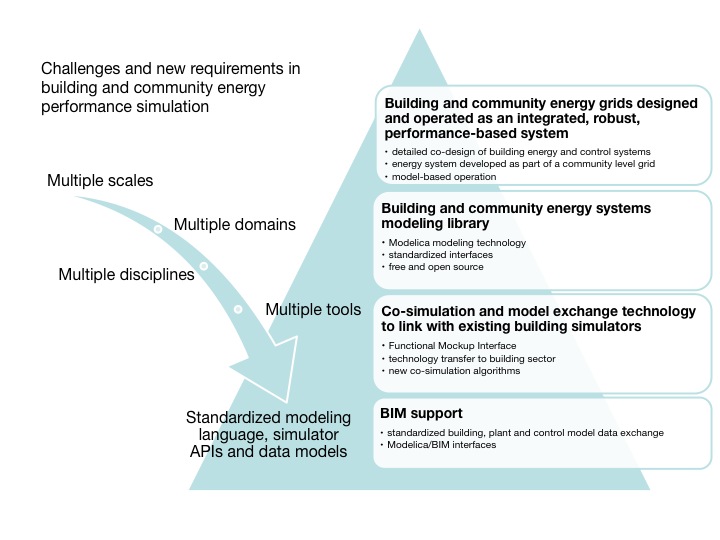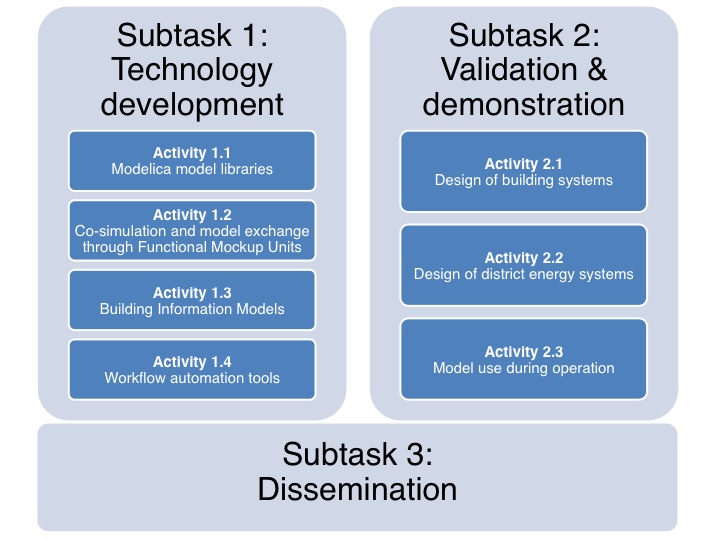IEA EBC Annex 60: New generation computational tools for building and community energy systems based on the Modelica and Functional Mockup Interface standards
Short Description
To meet increasingly stringent energy performance targets and challenges posed by distributed renewable energy generation on the electrical and thermal distribution grid, recent attention has been given to system-level integration, part-load operation and operational optimization of buildings. The intent is to design and operate a building or a neighborhood optimally as a performance-based, robust system. This requires taking into account system-level interactions between building storage, HVAC systems and electrical and thermal grids. Such a system-level analysis requires multi-physics simulation and optimization using coupled thermal, electrical and control models. Figure 1 summarizes the challenges that were addressed within this context through the use of a standardized modeling language, standardized Application Programming Interface (API) and standardized data models.
Modeling and simulation technologies that have been leveraged in this Annex were based on the object-oriented modeling language Modelica. The Modelica Standard Library contains more than 1300 models and functions that are open-source, freely available and well documented. However, the Modelica Standard Library does not have models for building or community energy systems. Also the need to couple legacy code and tools to Modelica was clearly recognized. The Functional Mockup Interface standardizes the application programming interface for inclusion of simulation models into other simulation programs. It also standardizes how different simulation programs can communicate with each other during run-time. Modelica and the Functional Mockup Interface (FMI) standard have been selected as they are industrial-strength, non-proprietary, industry-driven standards that allow technology transfer between the building performance simulation community and much larger dynamic modeling communities from controls, power-plant, electrical and thermal systems.
The Annex objectives were achieved by the participants collaboratively working on the Subtasks described summarized in Figure 2. Subtasks 1 developed the required software technology. Significant work already existed and was leveraged. Subtask 2 focused on validation, verification, demonstration and deployment of the developed software technology in the context of whole building and community energy performance design and operation. Subtask 3 developed a guidebook, organized special tracks at professional conferences, and ensured effective collaboration with professional organizations.
The Austrian contribution to the Annex focused on Activity 1.2 (Co-simulation and model exchange through Functional Mockup Units) and Activity 2.2 (Design of district energy systems). This included the development of FMI-compatible interfaces for relevant simulation tools as well as the simulation environment FUMOLA, which allows to use both the Modelica models developed in the Annex as well as external simulation tools. Furthermore, existing Modelica models for heaters (heating plants), distribution (DHC pipes) and customers (building models) were used to optimize the operation of district heating systems.
The tools and methods developed in the IEA EBC Annex 60 are relevant far beyond the scope of simulation and optimization of buildings and municipal energy systems. This applies in particular to the European and Austrian climate and energy targets, in the context of which a focus on system integration in the energy sector (especially through the coupling of energy sectors) is currently emerging as a central strategic element. Therefore, it was an important goal of the Austrian participation in the IEA EBC Annex 60 to develop a set FMI-compatible tools that can be used beyond the scope of the Annex itself. These tools have been published as open source software packages and are available to the general public:
- The FMI++ Library is a freely available software library that provides a variety of flexible tools for dealing with FMI-compatible models and simulators. This software library forms the basis of all FMI-relevant developments of the Austrian participation in the IEA EBC Annex.
- The FMI++ TRNSYS FMU Export Utility provides an FMI-compatible interface for TRNSYS, a popular building simulation tool. A so-called FMI adapter was developed, which, like any other component from the model library, can be integrated into a TRNSYS model.
- DIgSILENT PowerFactory is a popular and established tool for the modeling and simulation of electrical networks, for which it provides an extensive validated component library. With the FMI++ PowerFactory FMU Export Utility, the first FMI-compatible interface was developed for this simulation tool.
- The Functional Mock-Up Laboratory, or FUMOLA for short, is a simulation environment specifically designed for the integration of FMI-compatible models and simulators into a coupled simulation. During the development of FUMOLA an implementation from scratch was deliberately avoided. Rather, it was built on software components that were already in development or had been tested in applications.
Participants
Australia, Austria, Belgium, Canada, P.R. China, Czech Republic, Denmark, France, Germany, Ireland, Italy, Japan, Republic of Korea, the Netherlands, New Zealand, Norway, Portugal, Spain, Sweden, Switzerland, United Kingdom and the United States of America
Contact Address
AIT Austrian Institute of Technology, Energy Department
DI Dr. Edmund Widl
Giefinggasse 2, 1210 Wien
E-Mail: edmund.widl@ait.ac.at


